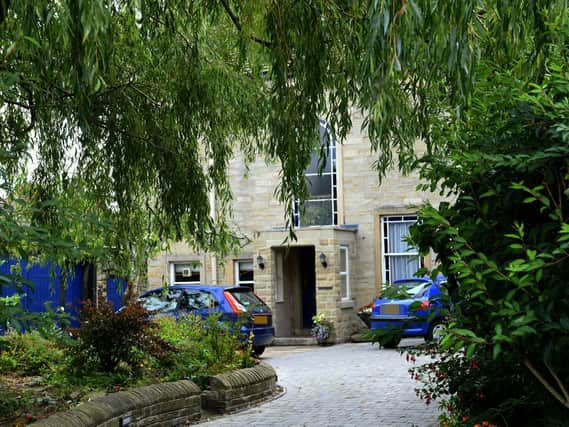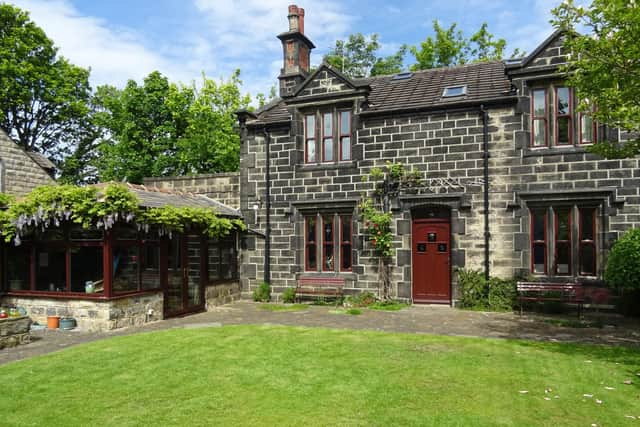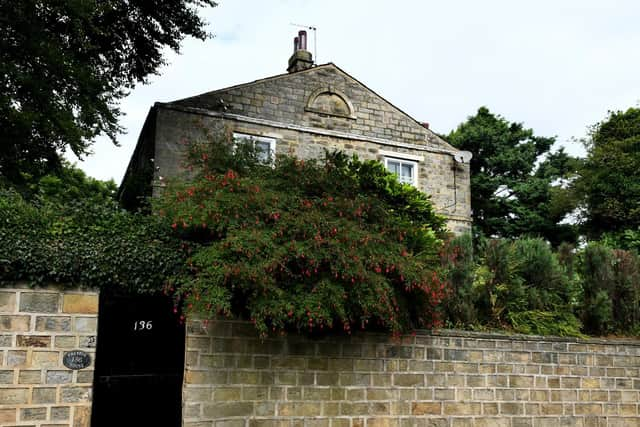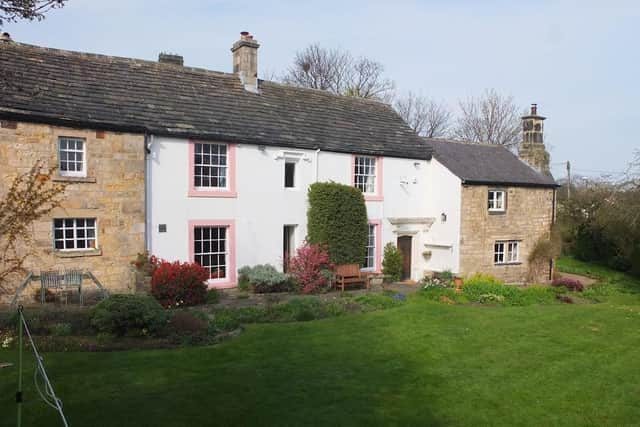A House Through Time: The other Leeds houses that were shortlisted to be featured in the fourth series


Production company Twentytwenty agreed to release information about the period houses on the original 'shortlist' to be featured - exclusively to the Yorkshire Post.
In most cases, they were eventually eliminated because research hit a 'dead end' or the lives of their occupants diverged away from Leeds and became less interwoven with the city's history.


Advertisement
Hide AdAdvertisement
Hide AdFive Grosvenor Mount in Headingley was selected because there were fewer gaps in chronology and plenty of depth and colour about the lives of its previous inhabitants was available.
In the majority of cases, current owners put forward their properties for consideration, with many able to offer some historical background that they had discovered themselves as a starting point.
An entire street was even nominated when the residents of Oakfield Terrace in Headingley submitted a joint proposal, in what was a first for the programme following three previous series in Liverpool, Newcastle and Bristol.
Preston House, Shadwell - a Georgian farm


Preston House was once part of a Georgian farm in what is nowadays a sought-after and affluent village to the north of Leeds, in the historic manor of Roundhay. Retired solicitor Robert Dyson and his wife Jenny bought the property in 1981 and still live there today.
Advertisement
Hide AdAdvertisement
Hide AdThere are records of buildings on the site from the late 1700s, when a house appears on old maps and was occupied by a small tenant farmer or 'husbandman' called Richard Snowdon. Like many families of the time, Richard suffered tragedy, losing a son at the age of two and his wife Mary at 37, possibly from epidemics of smallpox and typhus. His surviving son worked the land until around 1824, though it was owned by the Kitchingman family.
The house in its present form - it was later found to have been extended in the Victorian period - appears on a plan made as part of a survey for the Enclosure Act in 1807.
The farm then passed to the Dinwiddie family - they were Scots who had made their money in the cloth trade in Glasgow, and also had connections to the American tobacco economy. Landlord James Dinwinnie's uncle had even governed Virginia, but James's fortunes had fluctuated by the time he arrived in Shadwell with his wife Sarah in the 1820s. At this point, Richard Snowdon disappears from records, so he could have died or been evicted. The old 'croft' where the Snowdons lived was absorbed by the remodelled Preston House, a gentleman's residence where James's grandson Henry lived. James and Sarah moved to a grander home in Pool-in-Wharfedale.


Henry, a farmer and rug dealer, raised a family in Preston House, but later inherited his grandfather's Pool property and moved there too. His brother Nathaniel, who was unmarried, moved into Preston House, but researchers discovered that he also appeared to have had care for Henry's daughter Lydia. The mystery was explained by newspaper coverage detailing Henry's bankruptcy in 1837 and subsequent incarceration in a debtors' prison. By the time Lydia married, Henry was reduced to working as an innkeeper.
Advertisement
Hide AdAdvertisement
Hide AdBy 1864, Preston House was being advertised for rent in the local Leeds Intelligencer, and a tenant listed in the census is farmer James Backhouse, who later leaves to set up an agricultural machinery contracting business, reflecting the development of technology such as traction engines. By 1880, Shadwell seems to have lost some of its desirability, as there was press coverage referring to poor sanitation and cheaply built housing in the village. Preston House's tenant until around 1895 was baker and confectioner William Blenkin, who later became afflicted by religious mania and had his wills declared invalid. A servant called William Rodgers who appears in the 1871 census has become a prosperous fish merchant by the 1911 count.
In 1891, while William Blenkin still occupied it, Preston House was purchased by Joseph Walker, possibly the brother of Blenkin's wife. He died in 1900, leaving the property to his daughter Martha. It was still rented out, this time to engineer John Greig and his family, but there appeared to have been scandal before his marriage, as he was 'sued' by a woman named Julie Walker for seducing her daughter and getting her pregnant. John offered to marry the woman but was refused, though he agreed to pay her £300 in compensation. He later emigrated to Australia and died there in 1906.
By the beginning of the 20th century, Preston House was becoming respectable again, and was the home of brewery owner's son Alfred Hobson, a city councillor and clean water campaigner. The Hobsons' housemaid, Lucy Bulmer, is shown as having to give up her daughter to an orphanage and return to work after her husband's death, and died young herself.
Until about 1911 there was a brief period of occupation by cloth finisher Thomas Holroyd of the textile family, and by 1914 woollen travellor Alfred Pollard Bland had moved in. In the 1920s, the association with the cloth trade continued when Scottish draper Richard Kellett moved south to take a job as a representative for the Hope Manufacturing Company in Leeds, which produced raincoats and other garments. Richard was a self-made man who had begun as a draper's assistant but risen through the ranks, and regularly travelled to New York for work. He was successful enough to buy Preston House, where he lived until 1929, when he sold it to Captain Reginald Graham Ord.
Advertisement
Hide AdAdvertisement
Hide AdThe captain was a Royal Artillery officer who left Shadwell when he was posted to British India, and the family did not return to England until 1937. He appears to have served as an adjutant to a West Riding division, explaining his time in Leeds.
In the 1930s, the house passed to commercial traveller Charles Lane, whose wife Fanny died there. Charles remarried a much younger woman and ended up as the director of a nail manufacturing firm.
By 1939, the new owners were the Collinge family, though Preston House was requisitioned by the Commercial Union during the war. Accountant John Collinge was in the Army Pay Corps and his son Edgar fought in the Korean War in the 1950s.
They sold up in 1954, and Preston House was purchased by Richard Hainsworth, who worked for traction engine manufacturers J&H McLaren of Hunslet, which closed in 1959. He remained there until 1981, when the present owners the Dysons arrived.
Advertisement
Hide AdAdvertisement
Hide AdRobert, who is also a keen amateur historian, lived in Shadwell before buying Preston House, and used to regularly pass his future home. One of his three children now lives in the property next door, which the family also acquired, and his grandchildren now play in the same garden as their mother once did.
He said: "Our first house, bought in 1970, was half a mile away. We would often pass Preston House, but it was well hidden from view by well established trees. We went to view the house - and as soon as we had walked up the seven or eight steps from Main Street, we knew that this was the house for us!
"Before I retired, I was a solicitor in general practice in Leeds. I am an enthusiastic local historian, doing many walks and talks for the Leeds Civic Trust. It was always my intention to research the history of my house on retirement - this is something I have done and the additional help given to me by the TV production company has been very helpful in filling in a few more pieces of the ever-expanding jigsaw."
Waterloo Lodge, Bramley - a survivor in a vanished village
Bramley's post-war redevelopment is well-known and often lamented - numerous historic buildings in the west Leeds suburb were cleared to make way for new housing, leaving only a few survivors from the 18th and 19th centuries.
Advertisement
Hide AdAdvertisement
Hide AdOne of these is Waterloo Lodge, which has a strong association with one of the city's mill-owning dynasties. Nowadays, it's the home of Michael and Liz Meadowcroft.
Waterloo Mills, named after the Napoleonic Wars battle, were established in Bramley in around 1813 by John Haley. The Haleys were already prosperous local landlords keen for involvement in the booming cloth trade. The original yard still survives near Bramley Park, and Waterloo Lodge was built as the mill house. The Haleys were prominent in civic life until the 1930s, with John's descendant William serving as a councillor for Bramley until the war.
The first people to occupy Waterloo Lodge, in 1821, were John's daughter Mary and son-in-law, Mark Smith, who had been a business partner - though he later left the wool trade to manage Bramley Workhouse. They lost two children in infancy and Mark remarried after Mary's death. He later became embroiled in a court case when he was accused of abusing a young workhouse inmate and getting her pregnant. In 1830, he sold the house back to the Haleys.
Various members of the family remained powerful - Joseph Haley was involved in the Leeds delegation to the Great Exhibition in London, and was later elected as a Liberal councillor for the Bramley ward.
Advertisement
Hide AdAdvertisement
Hide AdBy 1854, Joseph had put the mills up for sale, but was still living at Waterloo Lodge. In 1856, a John Westmoreland Ellis was recorded as living there, and won an election to the town council on a ticket of opposition to a new tax which would have curbed pollution from the mills. However he died a month later aged just 31.
In 1861, William Yewdall, the 24-year-old heir to a woollen manufacturing firm, moved into Waterloo Lodge as a tenant of the Ellises. He had over 200 employees, yet struggled to manage them and was liquidated four times. His family bought Waterloo Mills and also ran Calverley Bridge Mills, but later went bankrupt.
In the 1880s the Ellis widow and son are listed as living at Waterloo Lodge, though the son later died in a lunatic asylum. The Ellises renovated the house, adding the mosaic floor and other Victorian features. In the 1891 census, it had passed to Ellen Ellis's unmarried sister. She died in the lodge eight years later.
By 1901, there was a new occupant with a connection to another thriving industry; railways. Robert Robinson had worked his way up from humble clerk to superintendent of goods traffic for the Great Northern Railway, and retired to Waterloo Lodge with his wife, having previously supervised the line at Headingley.
Advertisement
Hide AdAdvertisement
Hide AdIn 1905, Welsh colliery owner's daughter Edith Irwin moved in with her young sons. She was married to engineer Thomas Irwin, who appears to have been working in London at the time. Their sons both went east, with the eldest, John, working in tin mining in British Malaya and dying young there.
By 1912, the new tenants of Waterloo Lodge - by then still owned by Henry Ellis - were the Bolton family, who made their money from mineral oil manufacturing. Scriven Bolton was a keen astronomer who built an observatory in the grounds of the house. He died in 1929 during an influenza epidemic that swept through Leeds, aged just 42. This outbreak killed far more people in the city than the more famous Spanish flu - over 600 people died in just one week. His mother donated his astronomy equipment to the University of Leeds.
The mills had been sold to new owners long ago, and it was around this time - 1925 - when the site stopped being used for wool production. The buildings were demolished in the 1960s.
At the outbreak of war, two unmarried Bolton women lived at the lodge, and in 1945 a notorious murder took place on Waterloo Lane - the killing of 67-year-old shopkeeper Annie Nichols in her premises. The crime was never solved, but the Boltons would have known Annie and likely been her customers.
Advertisement
Hide AdAdvertisement
Hide AdIn 1956, a doctor named Terence Marshall bought the lodge from a family who had emigrated to New Zealand. He was the director of the blood transfusion centre in Leeds and raised his three sons there.
In 1981, Waterloo Lodge was purchased by former Leeds West MP Michael Meadowcroft, who still lives there today.
Oakfield Terrace, Headingley - home of movers and shakers
Oakfield Terrace became the first multiple household application in A House Through Time's four-series history when a group of 18 homeowners submitted a joint nomination.
Built in 1874, the terrace is one of the first examples in Leeds of a 'co-operative building society' formed when a group of individuals each wanted to invest in a house in one of the city's most fashionable suburbs.
Advertisement
Hide AdAdvertisement
Hide AdThe land they chose was a 10-acre site originally owned by the Church's Headingley Glebe estate, who sold it to speculators. Leeds estate agent Benjamin Richardson then bought a two-acre plot for the Oakfield Terrace Building Club. The land value had risen by 200 per cent during these transactions.
The club's original aim was to raise subscriptions to buy a plot and build 18 terraced homes on it. Richardson cannily offered architect William Hill, who had worked with Leeds Town Hall designer Cuthbert Broderick, a share in the scheme rather than a fee, and Hill's business partner T H Watson also became a shareholder.
They advertised in the Leeds Mercury, saying that the houses would have eight rooms each and large gardens, would be situated five minutes from the tram route and occupy a position that was 'the best in the district'
By August 1874, all 18 shares had been taken, with each founding member entitled to a house. At the completion of construction, all shareholders could occupy or sell their properties and the club would dissolve.
Advertisement
Hide AdAdvertisement
Hide AdThe semi-rural terrace stood alone beside a turning circle for the trams until further housing development along Grove Lane began in the 1920s. On its 100th anniversary in 1974, residents commissioned research about eminent past occupants.
Producers compiled research packs for three of the properties, and their owners have shared the information with us in this separate article on Oakfield Terrace.They uncovered numerous connections to the mills and engineering foundries as well as residents in professions such as medicine, journalism, architecture and law. A teenage lifesaver, a pioneering female doctor, a groundbreaking female tutor at Oxford, a TV documentary producer, two German-Austrian refugees, a rumoured Soviet spy, a troupe of Leeds Playhouse actors and an expert on the poet William Wordsworth have all lived on Oakfield Terrace.
Newlaithes Manor and Cragg Hill Farm, Horsforth - old houses with few records
Producers were initially excited when Joseph Waller nominated the Horsforth house he had lovingly renovated. Newlaithes Manor is thought to be the oldest dwelling in Leeds, dating back to the 12th century, when it was built as a tithe barn for the monks of Kirkstall Abbey, and has features spanning 800 years of history, including a linen fold, Tudor fireplace and mullioned windows. It last went on the market in 2012, when Peter and Ann Chadwick, who had lived there since 1977, sold to Joseph and his wife Kate, whose son was born in the house just a month later.
Advertisement
Hide AdAdvertisement
Hide AdYet the house's age counted against it, as researchers were unable to find sufficient source material that could flesh out a story arc suitable for a full series.
It was confiscated during the Dissolution of the Monasteries, and from 1566 until 1800 was occupied by one family, the Pollards, for a startling length of time, before it passed to the Micklethwaites until the late 19th century - though little information other than land tax entries were turned up for either.
The Joplings had moved in by the 1920s, and appear on electoral registers until around the outbreak of World War Two. Elizabeth Jopling placed an advert in a local newspaper in 1948 thanking people for their sympathy over the loss of a close relative, but gave her address by this time as the seaside town of Hornsea. The new occupants appear to be the Doyle-Davidsons, who appear in the press announcing their daughter's marriage to an army officer based at Catterick in 1955.
Joseph said: "It's fairly obvious really but the history and character of the house appealed to us. It's embedded in the history of Leeds from the 12th century onwards and it has links to local landowners and industrialists, like the Pollards who lived in the house for 300 years, and to Kirkstall Abbey - it was originally owned by the monks and then much of the later renovation of the house was built out of the material pulled out of the abbey as part of the Dissolution."
Advertisement
Hide AdAdvertisement
Hide AdIt was a similar dead end at Cragg Hill Farm, a 400-year-old property also in Horsforth. Owner Samantha Joyce believed that her centuries-old farmhouse would have many stories to tell - but in fact researchers drew almost a blank.
The oldest part of Cragg Hill dates back to 1610 and later additions are around 250 years old. It was a farm until the 1950s, and Samantha and her husband Mick, who own a double glazing business, bought it in 2002.
"I'd lived in Horsforth all my life but I never knew it was there. The owners were customers of ours and when my husband went to measure up a conservatory they offered to sell it to us. We live in the original house and they've moved to an extension they built."
Researchers uncovered a connection with Horsforth's prominent Stanhope family - distant relations of Samantha - who married into royalty, but other than an outbreak of anthrax on the farm - a common agricultural disease until it became better known as a biological weapon - little of note was revealed.
Advertisement
Hide AdAdvertisement
Hide Ad"We do have some original features, like a wooden door that's a few hundred years old and one of the handles is supposed to have come from Horsforth Hall before it was demolished.
"I was disappointed they didn't find much, and it was obvious the house wasn't going to be chosen for the programme."
Sue McGorrigan also nominated her Horsforth home, 87 Broadgate Lane - the oldest property on a now-built-up street.
"You can see it marked as two black dots on an old 1831 map. We are pretty sure it was originally a farm, with fields, orchards and cattle buildings. Old deeds show that the plot originally extended some great distance, right down to Low Lane, over an area that is now built up with council and ex-council housing.
Advertisement
Hide AdAdvertisement
Hide Ad"Our current house started out as part of a building linked to what is now number 89 Broadgate Lane, and was split into two properties and extended in the Victorian era - and then in the 1930s split into three properties. Additionally number 91 Broadgate Lane used to be the stables. The house has had various names, originally Nixon House (which is still partially visible, engraved onto the stone frontage), then Prospect Buildings or Villas, then Licklees House. Looking at censuses, it appears to have been rented out at times over the years."
A House Through Time starts on Tuesday September 7 at 9pm, BBC Two
Comment Guidelines
National World encourages reader discussion on our stories. User feedback, insights and back-and-forth exchanges add a rich layer of context to reporting. Please review our Community Guidelines before commenting.
